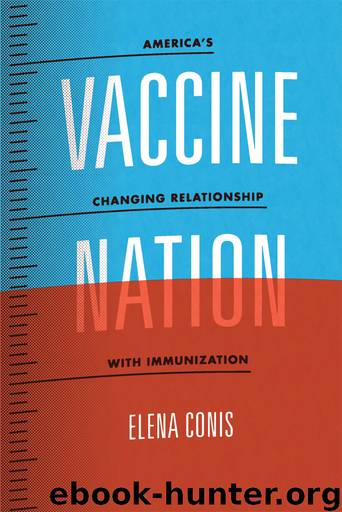Vaccine Nation by Elena Conis

Author:Elena Conis [Conis, Elena]
Language: eng
Format: epub
Tags: HIS000000 History / General
ISBN: 9780226923772
Publisher: The University of Chicago Press
Published: 2014-09-17T16:00:00+00:00
REJECTING HEPATITIS B VACCINE
The majority of state laws and regulations mandating hepatitis B vaccination for children went into effect between 1993 and 1998. Their adoption was largely streamlined by federal enthusiasm for universal vaccination and funding support for recommended vaccines, in addition to cultural preoccupations with the lifestyles of body-pierced youths and disease-harboring foreigners. While many of the laws and regulations were uneventfully adopted, a few minor debates did erupt. When Colorado’s health board proposed requiring the shot for kindergartners and seventh-graders in 1996, doctors and health officials were split on the issue. As with mumps nearly three decades before, health and medical experts in the state were neither united nor entirely clear on the urgency of vaccinating children against hepatitis B. Some noted that the American Academy of Pediatrics had advised the immunization of all older children only “where resources permit.” Some pointed out that the disease was unlikely to spread among elementary schoolchildren, “unless you have an infected child who’s a biter or who has a blood spill.”84 Others trotted out arguments about the risk-taking behaviors of teenagers: “We have a lot of children in this community who feel they’re invincible. . . . [T]hey experiment with sex and drugs, then die young because they get chronic hepatitis. . . . Since this is something we can prevent, we should prevent it,” said a county health director.85 But that argument didn’t hold water for everyone. “Just because we CAN vaccinate, does that mean we always should?” asked a Colorado state health department hepatitis B expert. “It’s a worthy public debate.”86
Those in favor of the health board’s proposal prevailed. By the fall of 1997, parents of all of the state’s incoming kindergartners and seventh-graders had to either provide proof of their children’s hepatitis B immunization or sign a form claiming a medical, religious, or personal exemption to the requirement.87 But as the requirement went into effect, popular opposition began to mount. In 1999 Patti Johnson, a member of the Colorado State Board of Education, began a campaign to encourage parents to question the vaccine, citing the small number of hepatitis B cases in young children (279 in 1996) and the large number of purported hepatitis B vaccine-related injuries reported to the federal government (24,776 between 1990 and 1999). Drug companies Merck and SmithKline Beecham hadn’t adequately tested the vaccine for long-term safety in children, she charged, and too few had questioned why this inadequately tested vaccine was being given to children to stop a disease that affects “IV drug users, prostitutes, sexually promiscuous persons, health care workers exposed to blood, and babies born to infected mothers.”88 At the Denver Post, columnist Al Knight repeatedly chimed in on the vaccine’s hazards, informing readers that New Jersey’s governor, Christine Todd Whitman, had vetoed a bill to require hepatitis B vaccines for schoolchildren.89 Whitman had cited the vaccine’s unknown duration of protection in her decision to postpone signing the bill; in Colorado her “refusal” to sign was described as a bold act
Download
This site does not store any files on its server. We only index and link to content provided by other sites. Please contact the content providers to delete copyright contents if any and email us, we'll remove relevant links or contents immediately.
| Administration & Medicine Economics | Allied Health Professions |
| Basic Sciences | Dentistry |
| History | Medical Informatics |
| Medicine | Nursing |
| Pharmacology | Psychology |
| Research | Veterinary Medicine |
Periodization Training for Sports by Tudor Bompa(8103)
Why We Sleep: Unlocking the Power of Sleep and Dreams by Matthew Walker(6566)
Paper Towns by Green John(5031)
The Immortal Life of Henrietta Lacks by Rebecca Skloot(4456)
The Sports Rules Book by Human Kinetics(4223)
Dynamic Alignment Through Imagery by Eric Franklin(4055)
ACSM's Complete Guide to Fitness & Health by ACSM(3943)
Kaplan MCAT Organic Chemistry Review: Created for MCAT 2015 (Kaplan Test Prep) by Kaplan(3913)
Introduction to Kinesiology by Shirl J. Hoffman(3700)
Livewired by David Eagleman(3628)
The River of Consciousness by Oliver Sacks(3505)
The Death of the Heart by Elizabeth Bowen(3492)
Alchemy and Alchemists by C. J. S. Thompson(3426)
Bad Pharma by Ben Goldacre(3217)
Descartes' Error by Antonio Damasio(3195)
The Emperor of All Maladies: A Biography of Cancer by Siddhartha Mukherjee(3028)
The Gene: An Intimate History by Siddhartha Mukherjee(3015)
The Fate of Rome: Climate, Disease, and the End of an Empire (The Princeton History of the Ancient World) by Kyle Harper(2978)
Kaplan MCAT Behavioral Sciences Review: Created for MCAT 2015 (Kaplan Test Prep) by Kaplan(2910)
